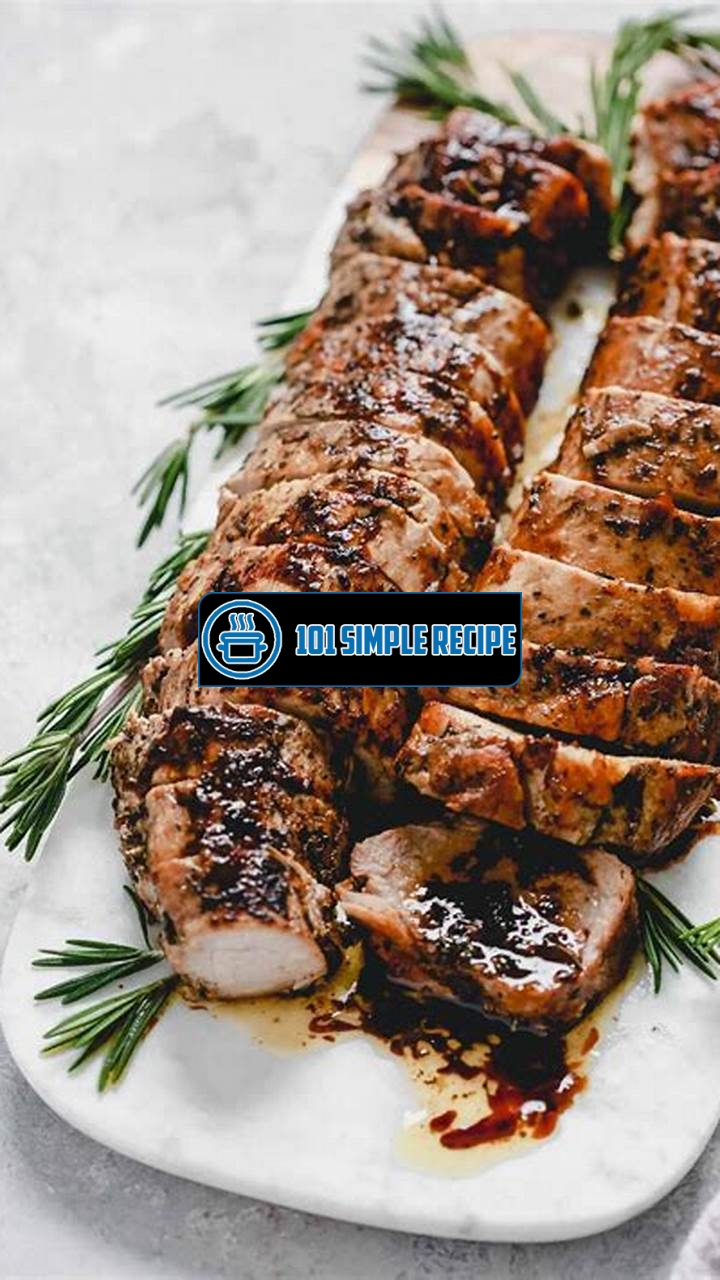Are you craving a delicious and healthy meal? Look no further! We have the perfect recipe for you – a mouthwatering roast pork that is guaranteed to satisfy your taste buds. This recipe combines juicy and tender pork with a perfect blend of savory spices, creating a dish that is bursting with flavor. Whether you’re cooking for a special occasion or simply want to treat yourself to a hearty meal, this roast pork recipe is a must-try. So roll up your sleeves, put on your chef’s hat, and let’s get cooking!

Understanding Healthy Roast Pork
When it comes to a delicious and healthy meal, roast pork is a fantastic option. Not only does it satisfy your taste buds with its juicy and flavorful meat, but it also provides numerous nutritional benefits. Understanding the key elements of healthy roast pork can help you make informed choices about incorporating it into your diet.
Nutritional Profile of Roast Pork
Roast pork is packed with essential nutrients that promote good health. Each serving of roast pork, approximately 3 ounces, contains approximately 250 calories, making it a great choice for those following a calorie-conscious diet. It is also a rich source of high-quality protein, essential for building and repairing tissues in your body.
In addition to protein, roast pork is a good source of several important vitamins and minerals. It contains significant amounts of B vitamins, including thiamin, riboflavin, niacin, and vitamin B12, which play a crucial role in energy production and cell function. Iron, zinc, and phosphorus are also found in roast pork, contributing to the overall nutritional value of this meat.
Moreover, roast pork provides a healthy dose of healthy fats. While it is true that fat content can vary based on the cut of pork chosen, roast pork generally includes monounsaturated and polyunsaturated fats, which are known to be heart-healthy.
Health Benefits of Roast Pork
Consuming roast pork as part of a balanced diet offers several health benefits. The high protein content in roast pork helps in muscle development, supports weight management, and keeps you feeling fuller for longer periods. This can be particularly beneficial for individuals looking to lose weight or maintain a healthy body weight.
Roast pork is also a good source of essential amino acids, which are the building blocks of protein. Amino acids are vital for various functions in the body, including promoting cell repair, supporting immune function, and aiding in the production of enzymes and hormones.
Furthermore, the vitamins and minerals present in roast pork, such as B vitamins, iron, and zinc, contribute significantly to overall health. B vitamins play a crucial role in maintaining energy levels, supporting brain function, and promoting a healthy nervous system. Iron is essential for transporting oxygen throughout the body, and zinc supports immune function and aids in wound healing.
Choosing the Right Cut of Pork
Choosing the right cut of pork is crucial to ensure a healthy and delicious roast. When selecting pork, opt for lean cuts such as pork loin, tenderloin, or center-cut chops, as they have less fat and fewer calories compared to fattier cuts like pork belly or shoulder. Trimming off excess fat before cooking can also help reduce the fat content further.
It is also important to consider the cooking method. Choose healthy cooking techniques such as roasting, grilling, or baking, which minimize the need for added fats or oils. Avoid frying or breading the pork, as this can significantly increase the calorie and fat content of the dish.
In conclusion, understanding the key elements of healthy roast pork can help you make informed decisions about including it in your diet. With its rich nutritional profile and numerous health benefits, roast pork can be a delicious and nutritious addition to your meals. Remember to choose lean cuts and healthy cooking methods to make the most of this flavorful meat.
If you’re looking to shed some pounds, this weight loss recipe pairs perfectly with roast pork.
The Science Behind Healthy Roast Pork
When it comes to enjoying a delicious and healthy meal, roast pork is a fantastic option for meat lovers. Not only does it offer a juicy and flavorful experience, but it can also provide several health benefits. Let’s dive into the cooking techniques and ingredients that make roast pork a healthy choice.
Low-Fat Cooking Methods for Roast Pork
One of the reasons why roast pork can be a healthy option is the cooking methods used. Instead of frying or deep-frying the meat, roasting it is preferred. Roasting involves cooking the pork in an oven, allowing the fat to melt away from the meat. This results in a lower fat content in the final dish.
Additionally, you can opt for using a wire rack while roasting. This allows the excess fat to drip down, further reducing the fat content of the roast. By choosing low-fat cooking methods like roasting, you can enjoy a healthier version of your favorite meat.
Marination and Flavoring Options
Marination plays a vital role in adding flavor to roast pork while keeping it healthy. By marinating the pork before cooking, you can infuse it with a variety of flavors without adding excessive amounts of fat or sodium.
You can experiment with different marinades that include ingredients like citrus juices, herbs, spices, and even low-sodium soy sauce. Not only will these marinades enhance the taste of the pork, but they can also contribute to its nutritional value. For example, citrus juices add a tangy flavor and are rich in vitamin C, which is beneficial for your immune system.
Using Lean Cuts of Pork for Better Nutrition
Choosing lean cuts of pork is another important factor in ensuring a healthy roast. Lean cuts, such as loin or tenderloin, have less fat content compared to fattier cuts like pork belly. This reduction in fat can make a significant difference in the overall nutritional composition of your roasted pork dish.
Lean cuts of pork are not only lower in fat but also higher in protein. Protein is essential for muscle growth and repair, making it a valuable nutrient for your body. By selecting lean cuts, you can enjoy a pork roast that is both delicious and packed with the nutrition your body needs.
By understanding the science behind healthy roast pork, you can create a meal that not only satisfies your taste buds but also contributes to your overall well-being. Remember to choose low-fat cooking methods, experiment with flavorful marinades, and opt for lean cuts of pork. Embrace the deliciousness of roast pork while taking care of your health.
Try making some ranch oyster crackers as a tasty side dish to accompany your roast pork.
Making Healthy Roast Pork at Home
Roast pork is a delicious and nutritious meal that you can easily prepare in the comfort of your own kitchen. Not only is it a delectable dish that satisfies your taste buds, but it also provides the essential nutrients your body needs. By following a few simple steps, you can create a healthy roast pork that will impress your family and friends.
Tips for Seasoning and Rubbing the Pork
Seasoning and rubbing the pork is an important step in creating a flavorful and juicy roast. There are various options for seasoning, depending on your personal preference and dietary restrictions. Here are some tips to enhance the taste of your roast pork:
- Marinate the pork overnight to allow the flavors to infuse.
- Use a mixture of herbs and spices, such as garlic, thyme, rosemary, paprika, and black pepper.
- Add a touch of sweetness with honey or brown sugar.
- Massage the seasoning into the meat to ensure it coats the entire surface.
Pro tip: Experiment with different combinations of seasonings to find your favorite flavor profile.
Slow Roasting for Tender and Juicy Pork
The key to achieving tender and juicy roast pork lies in the slow roasting technique. By cooking the meat at a low temperature for an extended period, the collagen in the pork breaks down, resulting in a melt-in-your-mouth texture. Follow these steps for perfect slow-roasted pork:
- Preheat your oven to 275°F (135°C).
- Place the seasoned pork on a roasting rack in a shallow pan.
- Cover the pork loosely with foil to retain moisture.
- Roast the pork for approximately 3 hours, or until the internal temperature reaches 145°F (63°C).
- Remove the foil and increase the oven temperature to 450°F (232°C).
- Continue roasting for an additional 15 minutes to achieve a crispy exterior.
Pro tip: Basting the pork with its own juices every hour during the slow roasting process will help keep it moist.
Serving Suggestions and Pairings for Roast Pork
Once your roast pork is cooked to perfection, it’s time to think about how to serve and pair it with other delicious ingredients. Here are some delightful suggestions:
- Serve sliced roast pork with roasted vegetables, such as carrots, potatoes, and Brussels sprouts.
- Create flavorful sandwiches by layering thinly sliced roast pork on crusty bread with your favorite condiments.
- Pair roast pork with a tangy apple or cranberry sauce to balance the richness of the meat.
- Alternatively, complement the pork with a zesty citrus glaze or a creamy mushroom sauce.
Pro tip: Don’t forget to garnish your plate with fresh herbs, such as parsley or cilantro, to add a pop of color and freshness.
In conclusion, making a healthy roast pork at home is not only satisfying but also a great way to enjoy a delicious and nutritious meal. With the right seasoning, slow roasting technique, and thoughtful serving suggestions, you can create a mouthwatering dish that will impress both your taste buds and your loved ones. So, why not give it a try and elevate your home-cooked meals with a juicy roast pork centerpiece? Enjoy!
Benefits of Including Healthy Roast Pork in Your Diet
Discover the advantages of incorporating roast pork into your meal plans for a balanced and healthy lifestyle.
Protein Boost and Muscle Recovery
Including healthy roast pork in your diet can provide a significant protein boost, aiding in muscle recovery and growth. Protein is essential for repairing and building tissues, making it an important macronutrient for anyone leading an active lifestyle or looking to improve their fitness regimen. Roast pork is an excellent source of high-quality protein, containing all nine essential amino acids that your body needs. Whether you’re an athlete or simply looking to support your overall health and wellness, incorporating roast pork into your meals can help you meet your protein requirements.
Furthermore, after an intense workout or physical activity, your muscles may experience small tears or damage. This is where the protein in roast pork can play a crucial role. By consuming roast pork, you provide your body with the necessary amino acids to repair and rebuild your muscles. This can aid in muscle recovery, reducing soreness and improving overall athletic performance.
Nutrient-rich Additions to Your Meals
Roast pork is not only a great source of protein, but it also offers a range of essential nutrients that can enhance the nutritional value of your meals. It contains various B vitamins, including thiamine, riboflavin, niacin, and B12, which are vital for energy production, brain function, and the formation of red blood cells. These vitamins play a crucial role in maintaining your overall health and well-being.
Additionally, roast pork is a rich source of essential minerals such as iron, zinc, and selenium. Iron is necessary for the production of hemoglobin, which carries oxygen throughout your body. Zinc supports immune function and plays a role in maintaining healthy skin. Selenium acts as an antioxidant, protecting cells from damage caused by free radicals.
Dietary Variety and Flavorful Alternatives
Including healthy roast pork in your diet can provide dietary variety and offer flavorful alternatives to your usual meal options. Many people find that incorporating roast pork into their meal plans helps them break the monotony of their daily meals. This can make healthy eating more enjoyable and sustainable in the long term.
Roast pork can be prepared in various ways, allowing you to experiment with different flavors and cooking techniques. From slow roasting to grilling, there are countless delicious recipes and marinades that can enhance the flavor of roast pork. By exploring these options, you can create exciting and nutritious meals that will keep you motivated to maintain a healthy diet.
Furthermore, roast pork can be a versatile ingredient in your dishes. It can be used in salads, stir-fries, sandwiches, and even tacos, offering endless possibilities for incorporating it into your favorite recipes. This versatility allows you to enjoy the benefits of roast pork while still adhering to your personal taste preferences.
In conclusion, including healthy roast pork in your diet can provide numerous benefits, including a protein boost for muscle recovery, essential nutrients for overall health, and dietary variety for flavorful alternatives. By incorporating roast pork into your meal plans, you can enjoy the delicious taste while nourishing your body and supporting a healthy lifestyle.
Ensuring Food Safety in Roast Pork
When it comes to preparing a delicious and healthy roast pork meal, it is essential to prioritize food safety. Understanding the importance of proper food handling and cooking techniques is crucial to prevent foodborne illnesses and ensure that you and your loved ones enjoy a safe and satisfying meal.
Safe Storage and Handling of Raw Pork
Proper storage and handling of raw pork are fundamental steps in maintaining its freshness and minimizing the risks of contamination. To ensure the safety of your roast pork, consider the following guidelines:
- Keep it refrigerated: Raw pork should always be stored in the refrigerator at a temperature below 40°F (4°C). This prevents the growth of bacteria that can cause foodborne illnesses. ️
- Separate from other foods: It’s essential to store raw pork separately from other food items, especially those that will be consumed raw, such as fruits and vegetables. This prevents cross-contamination and reduces the risk of introducing harmful bacteria.
- Use proper packaging: When storing raw pork, ensure it is wrapped tightly in plastic wrap or stored in a sealed container to prevent any leakage that could contaminate other foods in the refrigerator.
- Follow expiration dates: Pay attention to the “sell-by” or “use-by” dates on the packaging of raw pork. Consume it before the indicated date to ensure its freshness and quality. ⏰
Recommended Internal Temperatures for Roast Pork
Cooking roast pork to the correct internal temperature is crucial to kill any potential bacteria, ensuring it is safe to eat. Use a food thermometer to accurately measure the temperature. Here are the recommended internal temperatures for different cuts of roast pork:
| Cut of Pork | Internal Temperature |
|---|---|
| Pork Tenderloin | 145°F (63°C) |
| Pork Chops | 145°F (63°C) |
| Pork Roast | 145°F (63°C) |
| Ground Pork | 160°F (71°C) |
Note: The temperatures mentioned above are considered safe for pork according to the guidelines of the United States Department of Agriculture (USDA). Remember to let the roast pork rest for a few minutes after cooking to allow the internal temperature to rise by a few degrees. ️
Preventing Cross-Contamination and Proper Cleaning
Preventing cross-contamination during the preparation of roast pork is crucial to avoid foodborne illnesses. Here are some essential tips to follow:
- Keep surfaces clean: Before and after handling raw pork, ensure that all surfaces, utensils, and cutting boards are thoroughly cleaned with hot soapy water. This reduces the chances of bacteria spreading to other foods.
- Avoid reusing marinades: If you choose to marinate the pork, do not reuse the marinade that has come into contact with raw meat. Prepare a fresh batch or use a portion of the marinade exclusively for basting during cooking. ♻️
- Wash hands frequently: Proper hand hygiene is essential to prevent the spread of bacteria. Wash your hands thoroughly with soap and water before and after handling raw pork. ️
- Use separate utensils: When handling both raw and cooked pork, it is vital to use separate utensils to prevent cross-contamination. This includes tongs, knives, and cutting boards.
By following these precautions and guidelines, you can ensure that your roast pork meal is not only deliciously juicy but also safe and healthy for consumption. Remember, food safety should never be overlooked when preparing any dish, especially when it comes to meats. Enjoy your flavorsome roast pork responsibly! ️
This recipe for White Castle can be a delicious option for a healthy twist on roast pork.
Thank you for taking the time to read our article on healthy roast pork. We hope you found it informative and inspiring for your next culinary adventure. If you enjoyed this content, make sure to bookmark our website and visit us again for more delicious and healthy recipes. We are committed to providing you with valuable information and mouthwatering dishes that will satisfy your taste buds while promoting a balanced lifestyle. Stay tuned for more exciting recipes and cooking tips!
Frequently Asked Questions
Here are some frequently asked questions about healthy roast pork:
| No. | Questions | Answers |
|---|---|---|
| 1. | Is roast pork a healthy option for a balanced diet? | Yes, when prepared and consumed in moderation, roast pork can be a part of a healthy and balanced diet. It is a good source of protein and provides essential nutrients such as iron, zinc, and B vitamins. However, it’s important to choose lean cuts of pork and limit added fats and sodium in the cooking process. |
| 2. | What are some healthy alternatives to traditional roast pork? | If you’re looking for healthier alternatives to traditional roast pork, you can try using lean cuts of pork, such as pork loin or tenderloin, which are lower in fat. Another option is to incorporate more plant-based protein sources like tofu or tempeh into your dishes. Experimenting with herbs and spices can also add flavorful twists to your healthy pork recipes. |
| 3. | What are some cooking methods that retain the healthiness of roast pork? | To retain the healthiness of roast pork, it’s best to opt for cooking methods such as baking, grilling, or roasting. These methods require minimal added fats and help preserve the natural flavors and nutrients of the meat. Remember to trim excess fat from the pork before cooking and avoid basting with high-fat sauces. |
| 4. | Can I include roast pork in a weight loss diet? | Yes, you can include roast pork in a weight loss diet, as long as you watch your portion sizes and choose lean cuts of pork. It’s important to pair the pork with plenty of vegetables and incorporate other lean protein sources into your meals. Balance is key when it comes to weight loss, so enjoy roast pork in moderation alongside a well-rounded diet and regular exercise. |
| 5. | What are some healthy side dishes that complement roast pork? | Some healthy side dishes that complement roast pork include steamed vegetables, roasted sweet potatoes, quinoa salad, or a fresh green salad. Opt for nutrient-dense and fiber-rich options to create a well-balanced meal. |
| 6. | Can I freeze leftover roast pork? | Yes, you can freeze leftover roast pork. Make sure to store it in an airtight container or freezer bag to maintain its quality. When reheating, thaw the pork in the refrigerator overnight and then heat it in the oven or microwave until it reaches the desired temperature. |
Closing Thoughts
We hope this article has given you some valuable insights into the world of healthy roast pork. By choosing lean cuts, employing healthy cooking methods, and pairing it with nutritious side dishes, you can enjoy a delicious and guilt-free meal. Don’t forget to check back with us regularly for more tantalizing recipes and expert tips on maintaining a healthy lifestyle. Until next time, happy cooking!
Jump to Recipe
Healthy Roast Pork

Learn how to make a delicious and healthy roast pork that will satisfy your taste buds while promoting a balanced lifestyle.
- 2 lbs boneless pork loin
- 2 tablespoons olive oil
- 2 cloves garlic (minced)
- 1 teaspoon dried rosemary
- 1 teaspoon dried thyme
- Salt and pepper to taste
- Preheat the oven to 375°F (190°C).
- In a small bowl, combine the minced garlic, dried rosemary, dried thyme, salt, and pepper. Rub the mixture all over the pork loin.
- Place the seasoned pork loin on a roasting rack in a baking dish. Drizzle olive oil over the pork loin. Roast in the preheated oven for 1 hour and 30 minutes, or until the internal temperature reaches 145°F (63°C).
- Remove the pork loin from the oven and let it rest for 10 minutes before slicing. This will allow the juices to redistribute and keep the meat tender.
- Slice the roast pork and serve it with your favorite side dishes. Enjoy!






